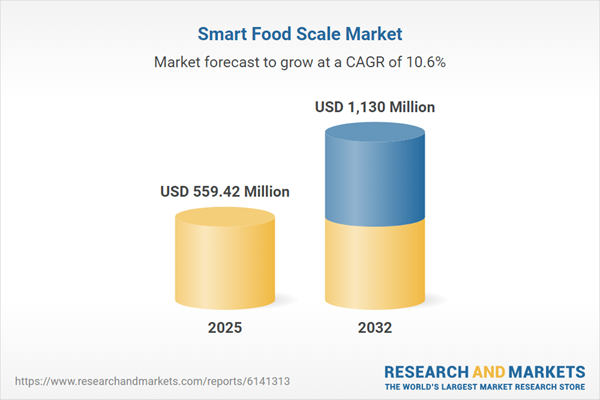Speak directly to the analyst to clarify any post sales queries you may have.
The Smart Food Scale Market is evolving rapidly as digital innovation meets growing professional and consumer demands for kitchen efficiency, data-driven nutrition, and seamless device integration. This transformation is redefining precision, reliability, and personalized health management in culinary environments worldwide.
Market Snapshot: Smart Food Scale Market Size and Growth
The Smart Food Scale Market grew from USD 508.33 million in 2024 to USD 559.42 million in 2025. It is projected to sustain momentum with a CAGR of 10.58%, reaching USD 1.13 billion by 2032. This trajectory underscores continuous demand from both residential and commercial users, propelled by market penetration of connected kitchen technologies and the rising emphasis on dietary data integration.
Scope & Segmentation of the Smart Food Scale Market
This report comprehensively covers the global smart food scale ecosystem, mapping out both current and emerging trends across product functionality, end-user verticals, distribution channels, and geographies.
- Weight Scale Ranges: Less than 1 kg, 1 kg–5 kg, More than 5 kg. Devices are positioned for portability, versatility, or industrial capacity depending on segment needs.
- End User Verticals: Commercial sectors (including bakeries and patisseries, catering businesses, culinary institutes, nutritionist/diet clinics, restaurants and cafés), industrial settings (such as food processing plants and nutraceutical or supplement labs), and residential consumers.
- Distribution Channels: Offline (healthcare/wellness stores, supermarket and hypermarket) and online. Channel strategies are adapted to cater to both mass-market and specialized audiences.
- Geographical Regions: Americas (including North America and Latin America), Europe, Middle East & Africa, and Asia-Pacific. Regional nuances influence product development, compliance, and go-to-market strategy.
- Core Technologies: Inclusion of sensors, wireless (Bluetooth, Wi-Fi) connectivity, advanced analytics and AI-driven applications, and modular hardware/software platforms that support integration and upgradability.
Key Takeaways: Strategic Insights for Decision-Makers
- Precision, interoperability, and user-friendly design are defining product differentiation. The shift from analog to connected scales enables real-time recipe guidance and integration with meal-planning or health-tracking platforms.
- End users across commercial kitchens, nutrition clinics, and households benefit from exact ingredient measurements, reduction of waste, and actionable dietary insights, responding to a broad spectrum of operational requirements and preferences.
- The rise of influencer-driven digital cooking and increased consumer emphasis on transparency is accelerating the normalization of smart food scales in daily routines across global markets.
- Manufacturers and distributors are refining supply chains and pricing strategies to address regulatory changes, competition, and evolving customer value expectations, particularly in light of shifting trade policies.
- Emerging alliances with technology partners foster rapid feature development and platform enhancements, resulting in continuous value delivery and market relevance.
Tariff Impact: Navigating Supply Chain Resilience and Cost Structures
Upcoming United States tariff adjustments will directly influence the sourcing of critical smart food scale components, notably sensors and wireless modules. Manufacturers are responding with supplier diversification and localized assembly, while balancing certification timelines and market readiness. Channel partners are reviewing product positioning strategies to sustain margins and adapt to potential shifts in consumer price sensitivity.
Methodology & Data Sources
This report utilizes a multi-stage approach, drawing from published literature, regulatory filings, industry interviews, and proprietary shipment data. Advanced analytics such as regression and cluster analysis, combined with scenario planning and peer review by experts, underpin the quantitative and qualitative insights provided.
Why This Report Matters for Senior Decision-Makers
- Delivers actionable segmentation, trend analysis, and competitive intelligence across all major smart food scale market dimensions, supporting high-confidence investment and product strategy decisions.
- Clarifies evolving consumer and regulatory requirements with respect to kitchen efficiency, connected health, and supply chain agility, allowing for more targeted business development and risk mitigation.
Conclusion
The Smart Food Scale Market is advancing through technological innovation, dynamic consumer engagement, and resilient supply chain practices. With actionable intelligence on product design, sourcing, and channel optimization, stakeholders can align strategies for sustainable growth and evolving user expectations.
Table of Contents
3. Executive Summary
4. Market Overview
7. Cumulative Impact of Artificial Intelligence 2025
Companies Mentioned
The companies profiled in this Smart Food Scale market report include:- Mettler‑Toledo International Inc
- Sencor
- American Weigh Scales
- Bonsenkitchen Trading Co., Ltd
- Canny Industrial Ltd.
- E. G. Kantawalla Private Limited
- Etekcity Corporation by Vesync Co., Ltd
- Escali Corporation
- Greater Goods LLC
- Joseph Joseph Ltd
- KOIOS USA Inc
- Lifetime Brands, Inc
- Nicewell Electronics Co., Ltd
- Nureca Limited
- OHAUS Corporation
- OXO InternationalLtd.
- Ozeri Corporation
- Perfect Company, Inc.
- ReFleX Wireless Inc
- Smart Diet ScaleInc.
- Tanita Corporation
- Weighmax International Corp
Table Information
| Report Attribute | Details |
|---|---|
| No. of Pages | 194 |
| Published | October 2025 |
| Forecast Period | 2025 - 2032 |
| Estimated Market Value ( USD | $ 559.42 Million |
| Forecasted Market Value ( USD | $ 1130 Million |
| Compound Annual Growth Rate | 10.5% |
| Regions Covered | Global |
| No. of Companies Mentioned | 23 |









